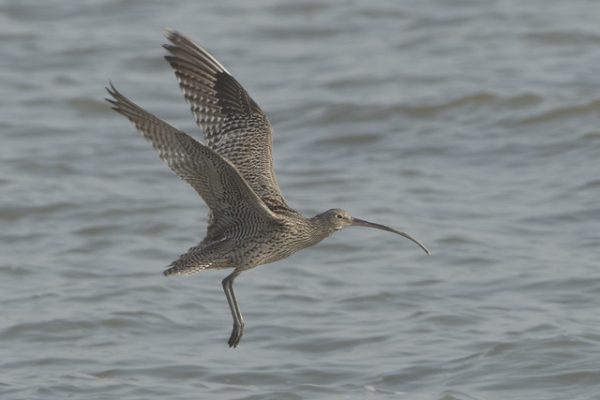-
Transboundary collaboration to save Far Eastern Curlew
Mark Carey (Chair) and Connie Warren (Coordinator) Far Eastern Curlew Task Force The Far Eastern Curlew Numenius madagascariensis is one of the largest shorebirds in the world. Its very large size (900 g) and very long bill (19cm) distinguishes it from other similar species in Australia and the East Asian–Australasian Flyway (Flyway). It is endemic to […]
Continue reading -
The Convention on Biological Diversity welcomes new Executive Secretary
PRESS RELEASE: Cristiana Paşca Palmer assumes position as Executive Secretary of the Convention on Biological Diversity 20 March 2017 Convention on Biological Diversity Cristiana Paşca Palmer today assumed office as the new Executive Secretary of the Convention on Biological Diversity (CBD), the principal global treaty on biodiversity. Adopted by governments in 1992 in Rio de […]
Continue reading -
湿地•视频︱破坏湿地,奢侈的浪费
选择其他语言: 2016年11月15日、保尔森基金会 中国的湿地并不仅仅是鸟儿的天堂,还蕴含着巨大的经济价值,向中国沿海地区的数百万居民提供的生态系统服务就价值约300亿美元。换句话说,湿地并不仅仅是候鸟的栖息地,还是具备实际经济价值的某种“自然资本”。 中外科学家和经济学家们正围绕“自然资本”进行开创性的工作,探索在环境保护中利用经济分析手段,也就是将自然赋予经济价值的种种渠道。 斯坦福大学的自然资本项目是这方面的领先者之一。该项目尝试开发多种工具,帮助各级政府在追求可持续经济增长的同时,评估和保护自然资本。 举例来说,中美洲国家伯利兹的政府正与斯坦福大学的自然资本项目合作,制定一套沿海管理规划,促进环境的可持续利用,令伯利兹人民和全球社会都从中受益。项目评估了在不破坏红树林的前提下,进行包括旅游业在内的沿海地区开发的地点和方式。红树林能够保护海岸线不受风暴袭扰。 中国的湿地不但是鱼类生长的乐园,更可以保护沿海居民每年免遭数十亿美元的气候灾害损失。与之类似,据斯坦福大学自然资本项目估算,目前,伯利兹沿海生态系统可以保护当地海岸每年免遭约50亿美元的经济损失。项目评估工具发现,游客每年在伯利兹沿海地区旅游天数总计200万天,当地每年龙虾捕捞量总计约24万公斤。项目据此制定了一套计划,在保护沿海土地的同时,促进旅游业和渔业收入增长。 一旦全球各国政府认识到湿地等自然资本的经济价值,而且这个价值可以量化体现,那么就更有理由保护自然资本了。 原文: http://www.paulsoninstitute.org.cn/index.php/paulson-blog/2016/11/15/video-the-economic-value-of-wetlands/
Continue reading -
The Economic Value of Wetlands (video)
Read in Chinese: 15 November 2016, The Paulson Institute China’s wetlands aren’t just about birds. As this short video shows, they have significant economic value, providing some $30 billion USD in ecosystem services to the millions of people who live in the country’s coastal regions. In other words, the wetlands not only provide habitat for migratory […]
Continue reading -
Tundra Swan re-sighting
Dr. Diana Solovyeva & Prof. Cao Lei With joint effort of Chinese and Russian Academies of Science the thirty Bewick’s Swans, the fourteen Bean Geese and two Greater White-fronted Geese were colour banded and tagged to follow their migration from breeding sites around Chaun Bay, Chukotka, Russia in August 2016. Bewick’s Swans are wearing red […]
Continue reading -
Pesta Sayap 2016 – Welcome to the Birds
[Press Release] 22 October 2016, Malaysian Nature Society The Malaysian Nature Society (MNS), with the support of Majlis Daerah Kuala Selangor and See Hoy Chan Sdn Bhd as its main partner, celebrated the arrival of migratory birds and its amazing fireflies at Kuala Selangor at its annual Pesta Sayap 2016 (Festival of Wings) event at the […]
Continue reading -
Satellite tagged bird spotted and photographed in China
17 November 2016 Rebecca Lee, Saving the Spoon-billed Sandpiper Today, Jonathan Martinez managed to catch-up with one of the satellite tagged Spoon-billed Sandpipers, HU, near the port town of Xitou in Guangdong province, China. HU has been at this site since the end of October, arriving a few weeks after being tagged on the Jiangsu coast. Jonathan shares […]
Continue reading -
Why ET, HU or CT might lead us to missing spoonie sites
15 November 2016 Rebecca Lee, Saving the Spoon-billed Sandpiper With the third Spoon-billed Sandpiper on the move, Prof. Rhys Green gives us his insights on why these three birds could lead us to as yet unknown sites, and how that could have important implications for conservation efforts. From Prof. Rhys Green The journeys of the three tagged […]
Continue reading -
Benthos Survey 2016
Chris Hassell, Global Flyway Network The field report Anna Plains and Roebuck Bay [EAAF 111] Benthic Invertebrate Mapping 2016 was produced at the Broome Bird Observatory in October 2016. The mud flats in Roebuck Bay are choc-a-bloc full of invertebrates for shorebirds. The writing and statistics in the report prove that Roebuck Bay is “the richest inter-tidal mudflat in […]
Continue reading -
湿地•视频︱拯救红腹滨鹬
选择其他语言: 保尔森基金会 红腹滨鹬每年秋季都要飞越两条危机重重的迁徙路线,才能抵达越冬地过冬。一条是东亚—澳大利西亚迁飞路线,这条路线上的多处停歇地因围填海工程等人类活动而遭到破坏。而在另一条迁飞路线—-经美国抵达南美洲最南端的火地岛的路线上,红腹滨鹬则因鲎(俗称“马蹄蟹”)的过度捕捞而陷入困境。中国沿海湿地的迅速消失给红腹滨鹬带来极大威胁。让我们通过康奈尔鸟类学实验室的介绍来了解这种美丽、但受到威胁的候鸟。 红腹滨鹬 事实 红腹滨鹬和其它许多鸟类一样,不会倒嚼未消化的坚硬食物,而是直接通过粪便排出。因此,研究者可通过分析粪便内容物来了解其食物消化率。 迁徙途中,红腹滨鹬会在传统的停歇地大量聚集,位于河北省唐山市的滦南湿地便是其中之一。由于红腹滨鹬的主要食物—光滑河蓝蛤的密度高,每年春季,东亚-澳大利西亚迁徙路线上80%的红腹滨鹬都会在此停歇、觅食,以补充能量。但是,由于滦南湿地周边地区被围垦,红腹滨鹬的生存已经受到极大威胁。该湿地的保护状况直接决定着红腹滨鹬能否顺利抵达北方、并成功繁育后代。 在地球的另一边,美国的特拉华湾是红腹滨鹬春季迁徙途中的一处重要停歇地,此时正值鲎的产卵季,鲎卵就成了红腹滨鹬的美食。每年此时,大量的红腹滨鹬格陵兰亚种种群聚集于此,我们甚至可以在一天之内看到该种群近90%的个体。但是,人类对鲎的过度捕捞使得红腹滨鹬食物短缺,导致其种群数量急剧减少。 据环志记录,最长寿的红腹滨鹬个体至少可以活15年零11个月。1986年,一只红腹滨鹬在美国新泽西被戴上鸟环;2001年,这只红腹滨鹬在特拉华的一次环志行动中被再次捕获,并被放飞。 食性:主要以无脊椎动物为食,尤其是双壳类、小型腹足类和甲壳类动物。繁殖期间也以陆生无脊椎动物为食。 习性:红腹滨鹬喜欢在浅水处觅食,有时将喙插入泥水中探觅食物,可以吞食整只小型软体动物。虽然红腹滨鹬在越冬地会聚集成群,但它们的繁殖对会占据繁殖领地,彼此往往要相距1公里左右。 保护:红腹滨鹬是全球性物种,《IUCN红色名录》已将其列为近危种。在传统的迁徙停歇地大量聚集的习性使得红腹滨鹬易受污染和关键食物资源丧失的威胁。河北滦南湿地的红腹滨鹬种群数量最高时曾达6万只,但近年来由于周边区域的围垦等因素,2015年其数量已经下降到2万余只。在北美洲,红腹滨鹬有三个亚种,数量也都在减少。从1980年代中期到2003年,从北美洲迁徙至南美洲越冬的红腹滨鹬种群数量已经减少了50%以上,而被列入美国“联邦受胁物种名录”。2012年的调查显示,红腹滨鹬三个北美亚种种群的繁殖个体总数约为13.9万只。北美红腹滨鹬被列入“2014年美国鸟类状况观察名录”,这意味着如果不采取保护行动,这些种群将成为受胁或濒危种群。 原文: http://www.paulsoninstitute.org.cn/index.php/paulson-blog/2016/11/08/video-saving-the-red-knot/
Continue reading


